Foundation of Mercy Sisters
The Congregation of the Sisters of Mercy was founded by a Dublin woman, Catherine McAuley on 12th December, 1831 in Baggot Street Dublin. She was a woman of deep faith and prayer, who had a warm heart for people, especially for the sick, the suffering, the poor and deprived. Mercy, God’s loving compassion is the Congregation’s special charism. She charted out a new way in which women could play an important and integral role in Church and Society.
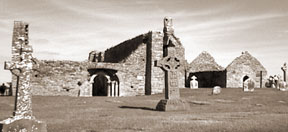 High Cross at Clonmacnois
High Cross at Clonmacnois
History Of The Diocese
The Diocese of Ardagh, as distinct from Clonmacnois with which it is now united, takes its name from the village of Ardagh, now a picturesque village in Co Longford. St. Patrick came and founded a Church in Ardagh, appointing St. Mel, his nephew, as its first Bishop. Thus the history of Ardagh goes back to the dawn of Christianity in Ireland. The episcopate of Bishop Cheevers (1751 – 1756) was marked by the joining of Clonmacnois to Ardagh. The combined dioceses include all Co Longford, half of Co Leitrim and parts of Westmeath, Offaly, Cavan, Roscommon and Sligo. 65 Bishops have been recorded presiding over the 41 parishes which constitutes the Diocese of Ardagh and Clonmacnois.
The Sisters Of Mercy

The Sisters of Mercy have been part of the Church in the Diocese since 1861 and have carried with them the spirit of Catherine McAuley. That spirit they planted, others watered it and God gave the amazing increase. From the beginning to the present, they have been involved in Christian education of the young, adolescents and adults, in Childcare Homes, Hospital care, Parish and Family Ministry, in Visitation, Children of Mary, Parish Choirs, Sodalities, St. Vincent De Paul Society. Prayer and Service flow together reciprocally in the life of the Sister of Mercy.
Mercy Foundations
11th April, 1861 – Longford:
Fr. Philip Maguire PP of Clough donated the sum of £2,000 to Bishop Kilduff to found a Convent in the Cathedral town of Longford. On 11th April, 1861 Rev. Mother Mary Mercy Norris, Superior of Baggot Street with Sr. Bernard Maguire, Sr. De Sales Fallon, Sr. Gertrude Gordon, accompanied by two Novices, established the Convent of Mercy, Longford. It was the first Convent to be founded in the Diocese since the Reformation. Their temporary Convent was in two houses on Keon’s Terrace where they started an Infant School. They began life without furniture for their School and what was known as the Convent had scarcely a table.
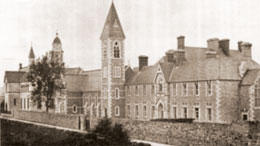
On 24th October, 1874 the Sisters took up residence in the new Convent – St. Joseph’s – near the Railway Station. In 1861, Scoil Mhuire was established as a small Pension School, at the back of the Cathedral. This Senior Girls’ Academy, as it was called, continues today as Scoil Mhuire. To help in this work, Srs. Philomena McCann, Gabriel Murphy and Aquin Whelan took on this work. From the beginning, the work of visitation of the sick and poor in their homes was carried out by the Sisters.
On 4th December, 1886, St. Joseph’s Convent National School was opened. In 1954 permission was sought to erect a new Primary School to replace the old one which was no longer suitable for modern needs. To lessen the debt of almost £100,000 the Community provided a site and gave a generous contribution in cash. It was completed in 1957, an ultra-modern school was built close to the old one, which accommodates 600 pupils.
In 1961 the old Primary School was renovated and a new wing was added on, to provide a new Secondary boarding and day school. It consisted of Classrooms, Music Rooms, Dining Room, Kitchen and Toilets. With increasing numbers many spacious extensions were added over the years; and so the Mercy work continues to this day.
From the Longford mother house many branch houses were founded.
30th December, 1869 – Newtownforbes, Co Longford:
Newtownforbes Convent was founded from Longford at the request of the Earl of Granard for the Sisters to work among the poor in the area. He gave the Sisters a fine two storey house, formerly known as The Parson’s House, as a residence, which they named Nazareth. The three founding Sisters were – Sr. Philomena McCann, Sr. Gabriel Murphy and Sr. Gertrude Gordon. It became independent from Longford on 29th June, 1871 and Mother M. de Sales Fallon was appointed Superior by Bishop Conroy. At first they taught in a small school at the top of the town. Within three years the Convent, The Girls Primary School, the Orphanage, Industrial School and Laundry were built. Many of the orphans were brought there because they had been abandoned; others because of the death of parent/parents. The age range was from infancy to 16 years. In the Industrial School the girls were taught knitting, sewing, painting, embroidery, lace-making and crafts.

The Orphanage was phased out in the late 1960’s due to diminishing numbers. The Sisters continued teaching in the Girls’ Primary School until it was amalgamated with the Boys’ School in 1994. Sisters continued their ministry on the staff until the school closed in 2003.
Weekly Prayer Meetings were held in the Convent for over 30 years.
In 1951 a flourishing Secondary Day and Boarding School were opened, where previously there had been a Secondary Top. The Boarders resided in a large building opposite the Convent, which formerly was the Novitiate of the Amalgamated Convents from 1920 to 1929. This building is now a Nursing Home. Some years after the introduction of Free Education/Transport the Boarding School was phased out. In 1992 a new Secondary School was built and operated until
8th September, 1878 – St. Josephs Hospital, Longford:
Longford Union Workhouse was opened in 1840 to provide shelter and medical care for the elderly and destitute of the County. The running of the Workhouse was the responsibility of the Board of Guardians, who in turn appointed the Master, Matron, Teacher, Porter and other Staff. It was built to house 1,000 people but in 1848 there were 2,318.
In July 1878 the Sisters began visitation in the Union Workhouse in Longford. On the 8th September, 1878, Srs. Aloysius Martin, Stanislaus Tunney and Berchmans Kirby took up residence in the Workhouse and began their work among the sick poor in the Hospital. Like many institutions of that time, it was gloomy and depressing, but the Sisters took up duty with remarkable courage. They continued their work in the Workhouse down the years. Since 1924 a Chaplain has been appointed to the Hospital and Mass is celebrated daily.
In 1921 the new Free State Government removed the stigma of the “Workhouse” name and the Building then became known as The County Home. In 1952 it was renamed as St. Joseph’s Hospital. The old Fever Hospital was completely modernised and is now named Mt. Carmel. By the late 1960’s the Old Workhouse/County Home building was gradually demolished and replaced by the present day St. Joseph’s Hospital Complex, which includes X-ray Department, Casualty, Physiotherapy, Occupational therapy, Catholic and Church of Ireland Chapel, a Convent, Individual residential units and Day Care facilities.
The work of upgrading the Hospital was commenced in 1967 and through the persevering efforts of Sr. Calasanctius Duffy and her devoted staff has continued on a phased basis until the present time. For the last 125 years, the Sisters of Mercy have worked tirelessly and continually in this healing ministry.
31st March, 1880 – Mohill, Co Leitrim:
In answer to a request from Rev. Dean Eivers, PP, Mohill, five Sisters – Mother Joseph Howley, Sr. Aloysius Martin, Sr. Agnes Ryan, Sr. de Pazzi McDermot and Sr. Stanislaus Tunney left Longford to open a new Convent in Mohill, Co Leitrim. Sr. Catherine McGaver joined them later. Their “Convent” was a second storey, built over the Primary School for Boys and Girls. Sr. Aloysius was appointed the Superior of the Community and Sr. de Pazzi was given charge of the Primary School.
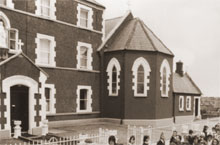
In November 1890 this – less than adequate School was replaced by the much needed two storey building on the opposite side of the road. The School was blessed by Rev. Dr. Woodlock. It was thus that St. Joseph’s Primary School began and still exists today.
In addition to the work of teaching, the Sisters, in 1882 acceded to the request of the Medical Authorities to take charge of the Workhouse Hospital where there were, at that time, 300 patients. Srs. Clare Banahan, Vincent Howley and Magdalene Fahy (nursing Sisters) were accommodated in the Workhouse. Srs. Patrick (Bridget) O’Sullivan, Aloysius Martin and Berchmans Bermingham taught in the Workhouse School.
This work continued until its closure by the County Council in December, 1922. Mohill Convent became an independent house in January 1886. The influence of the Sisters spread all through the Parish and beyond.
In the late 1940’s Sr. Clare Fox had a vision for Secondary Education in Mohill and in 1949 under her direction a Secondary Top was started in the Cloakroom of the Primary School. From these humble beginnings the School grew and flourished. In 1954, due to the increasing numbers the Sisters gave over a wing of the Convent building to accommodate the School community. In 1963 at the request of Bishop McNamee the School was opened to boys.
In 1966, the Rynn Boys School, which had been set up by Fr. Ignatius McLoughlin, amalgamated with the Girls Secondary School. In 1969 a completely new School was opened in Mohill – The Marian College, where the Sisters continued to teach until retirement.
2nd February, 1882 – Granard, Co Longford:
The massive mound of the Motte gives a clue to the antiquity of Granard. It is the remains of a fifth Century residence of Cairbre, son of Niall of the Nine Hostages. It was here that St. Patrick came and left St. Gusacht in charge of the Church.
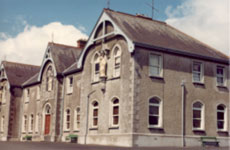
In 1842 a Union Infirmary/Workhouse was built. The records of 1850 show that there were 269 males and 417 females enrolled. It was to this Workhouse, at the invitation of Dean O’Flanagan, Dean of Granard and Bishop Woodlock, that the Superior, Sr. de Sales Fallon sent Sisters Mercy Flood, Francis Hoare and Magdalen Frost from Newtownforbes to take up nursing the poor, sick and neglected people in the Infirmary. Srs. Bernard Maguire, Gertrude Quinlan and Brigid Burke taught in the Workhouse School and visited the sick and poor in the locality. Their ‘Convent’ was the middle ward of the Infirmary. They continued to teach in the Workhouse School in which they also taught Sewing, Knitting, Cookery, until 1922, when the Workhouses were merged into one in Longford – later known as The County Home.
The professional skills of Lace making and Embroidery were developed among the people both inside and outside the Workhouse and many homes boosted their meagre income by the money earned from their work. Springlawn House, opposite the Workhouse, was rented from a Mr Pettit, where the Sisters lived for 12 years and in 1894 the Sisters took up residence in the new Convent. Srs. Stanislaus Rochford and Michael Clancy took charge of the town’s National School. The Stables were renovated as classrooms. In 1891 the Convent Primary School was built on a site given by the Sisters and was financially supported by the local priests and people. In 1978 the School was replaced with a modern School on the same spacious site. In 1990, this Convent School was amalgamated with the town Boys’ School. It is now known as The Sacred Heart Primary School and is still situated on the Convent School Campus. 20th July, 1891 – Granard became an independent Convent from Newtownforbes with Sr. Joseph Hoare as Superior.
1942 – 1947, the Sisters had continuation classes set up in the Workhouse Lodge for girls, who continued School until they were 15, 16 or 17 years of age. They taught the usual subjects with special emphasis on Cookery, Needlework, Arts and Crafts.
September 1947, Sr. Dolores Finnegan was the inspiration behind the setting up of the Secondary School – Cnoc Mhuire. The Sisters had the same Workhouse Lodge ready to receive the first pupils in September 1947. So it came to be that Cnoc Mhuire was born and opened its doors to the girls of the area with Sr. Clement Siney as Principal, Sr. Patrick Murphy as Manager. They were ably assisted by Sr. Teresa Stack.
From 1949 the School became a Boarding as well as a Day School. Secretarial Skills, Music and Drama were an integral part of the Curriculum. In 1954 a large Assembly Hall, with Dormitories overhead containing 40 fully equipped individual cubicles, was built which was totally financed by the Community.
1959 – Another milestone in the history of Education took place when Cnoc Mhuire became one of the first Co-Educational Schools in the country.
1968 – 1970, with the advent of Free Education /Transport, major expansion took place with the building of a 20 classroom block. In 1982 a two storey block was erected – with Sports Hall, Oratory, Computer Room, Music Room and Laboratories. All sites were given by the Sisters. The Mercy Education Tradition continues in Granard.
1961 – St. Josephs Knitwear Industry, Granard, Co Longford:

The Industry was set up in 1961 in a small room attached to the Workhouse Lodge, to give employment to young people who were facing emigration. There was no Free Education then and no Factory in Granard. This was the brainchild of Sr. Paul Torpey, who began with one knitting machine and 6 lbs of wool! Out of these small beginnings sprung an ultra-modern Industry which has employed 10 workers in the factory and 20 home knitters. It supplied uniform jumpers and cardigans to at least 20 Secondary Schools throughout the country and had markets in Ireland, UK and USA for Aran Sweaters.
It was closed down in 1987. The two senior members of the staff set up the Industry on the outskirts of the town. The machinery was transferred to that premises, where the work continued for many years, known as Árd Cross Knitwear, situated in Ballinacross, Granard.
1986 – Rath Mhuire Resource Centre, Granard, Co Longford:
The Resource Centre was started in 1986 as a result of an invitation from the Midland Health Board to the then Mother General for a Sister as a Community Worker. Sr. Maeve Brady has been involved in this work since the beginning. The work has developed and expanded over the years and includes Adult Education, Home Management, Secretarial Skills, Personal Development, Women’s Groups, Summer Camps, Counselling Services and Bereavement Sessions, Drop-in Centre, Carer’s Course, Writers Group, Reiki Group, Reflexology Diploma Course. The Midland Health Board monitors, funds and supports the Centre in a very positive way. An outreach of the Centre has developed in The Dolmen Fáilte Club in Aughnacliffe, Co Longford.
19th March, 1899 – McGoey Factory, Longford:
The McGoey Factory or House of Industry for poor girls in the locality was established in Longford and managed by the Sisters of Mercy. About 28 workers were enrolled and Knitting, Irish Crochet, etc. were taught. Markets, both within the country and overseas, were secured for this beautiful and useful work produced by the girls.
4th January, 1900 – St. Elizabeths, Edgeworthstown, Co Longford:
Maria Edgeworth ran a School for the poor of the town. Elizabeth Ross, who resided in America had property and many connections and interests in Edgeworthstown. She sent £1,000 to Bishop Woodlock and another £1,000 to Bishop McNamee for the purpose of erecting a Convent in the town. Bishop Woodlock offered the proposed Foundation to the Longford Community, which they accepted.
A house, formerly Cullen’s Drapery, now Quinn’s Hardware Stores, was purchased, and on 4th January, 1900, four Sisters – Bridget Glynn, Teresa Lamb, Joachim Rodgers and Ignatius Harold left Longford to found the Convent in Edgeworthstown. They were involved in Visitation and teaching, where they began with a Pension School. When that building became inadequate a 5 acre field was purchased outside the town on which the Convent was built in 1900. The Sisters took over the new National School built in 1905 to accommodate 200 pupils. This School still exists and in the year 2000 was amalgamated with the Boys’ School.
In 1946 Srs. Rosario Deery and de Sales (Elizabeth) O’Neill, established the Secondary School which was held in one classroom of St. Elizabeth’s Primary School. It was co-educational and inter-denominational from the outset. In 1947, two rooms in the Manor building were used as classrooms. Before the Manor was renovated as a Nursing Home, the outdwellings were converted and used as Secondary School classrooms until 1967, when they transferred into Pre-fabs in the grounds of St. Elizabeth’s Convent.
With the coming of Free Education/Free Transport, it was phased out as a Secondary School.
1926 – St. Brigids, Ardagh, Co Longford:
 St Brigid’s, Ardagh in the snow
St Brigid’s, Ardagh in the snow
After the free State was set up, Rural Domestic Economy schools were established by the State. The Fetherstone Estate and Lodge, Ardagh came on the market. The Superior of the Longford Convent had a vision to set up a similar RDE School in Ardagh.
After consultation with the Community, the Fetherstone Lodge was purchased by them, with the aim of setting up a Rural Domestic Economy School for the training of young girls.
On 11th July, 1927, Srs. Brigid O’Rafferty, Carmel Kearney and Malachy Tighe left Longford to begin the pioneer work there after reconstruction and improvements had been made to the building. Srs. Perpetua Bolger and Agatha Duffy were among the first group of pupils.
Domestic Science, Dairy and Poultry, Laundry, Cookery, Arts and Crafts etc. were taught efficiently by trained and experienced teachers. It was grant-aided from the beginning by the Department of Agriculture until the mid 1980’s, when grants ceased to be paid to such Colleges. The Sisters financed the School for one year. In order to meet the needs of the day, the College changed focus and included Urban and Rural girls. It was funded for two years by the Youth Employment Agency and in recent times by FAS. It is now known as St. Brigid’s College for Further Education and Training.
It is the only residential College of its kind in the country. Modules now include Computer and Office Applications, Childcare, Food and Cookery, Restaurant and Hospitality Skills, Horticulture, Health and Safety, Personal Development, Textiles and Crafts. A large Conference Hall, Catering and Dining Areas and offices have been added recently.
For over 76 years the Sisters of Mercy have continued the work begun in 1927.
15th September, 1944 – St. Mel’s College, Co Longford:
At the request of Bishop McNamee, three Longford Sisters took charge of the “temporals” in St. Mel’s College. A new Convent was built for their use. The first Sisters were – Agatha Duffy, Thecla Treacy and Felicitas Geraghty.
16th April, 1952 – Our Lady’s Nursing Home, Edgeworthstown, Co Longford:
The ancestral home of Maria Edgeworth was acquired by the Longford Sisters in 1947. It was a deed of gift from Mr Bernard Noonan, a native of Edgeworthstown, who lived in America.

All the big houses, including The Manor in Edgeworthstown, were taken over by the Military for Training as a preparation, to defend the country in the event of War, between 1939 and 1945 World War 2. The house was vacant for some time and had deteriorated.
Mr Noonan contacted the Bishop to see if this house could be used for a good purpose. It was then that the Sisters of Mercy Longford were contacted and they acquired the premises and some land.
In 1948, Srs. Malachy Tighe, Ursula McGuinness and Oliver Currid took up residence in the Manor. From basement to attic the house was refurbished and it was only in 1951 that it was ready for occupation as a Nursing Home. The Manor Nursing Home did not receive any State grant at that time.
 ‘The Manor’ by Jenny Sharkey
‘The Manor’ by Jenny Sharkey
On 16th April, 1952, Our Lady’s Nursing Home was opened. It included a Maternity Unit, which continued until the late 1970’s. Many extensions were added on, including a beautiful Chapel and Mortuary, a large Dining room, bedrooms and Conservatory. From 1951 until the present Our Lady’s Manor Nursing Home has been a place of comfort and welcome where excellent nursing care and the spiritual and physical well-being of the patients is a priority.
16th July, 1861 – Moate, Co Westmeath:
The Convent of Mercy, Moate was founded from Kells, Co Meath on the feast of Our Lady of Mt. Carmel, under the patronage of Bishop Kilduff of Ardagh and Clonmacnois.
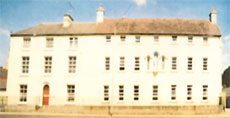
Mrs Colgan owned a Drapery and Grocery shop in Moate. Her husband died and she wished to bring Religious to her native town, to serve the people by visiting the sick and aged and to open schools for the children of Moate. She entered the Convent of Mercy, Kells, and was received in October 1860 and given the name Sr. M de Chantal. Her Profession took place in the old Parish Church in Moate on 15th October, 1861. She sold her house, bought a three storey house opposite the old Parish Church for the foundation of the Convent.
She became the Foundress of the Convent, with four other Sisters from Kells. Immediately, the Sisters began visiting the sick and teaching girls, the latter in a Coachhouse at the rear of the Convent. When the number of Sisters increased they bought the neighbouring house. These two houses formed the Convent until the early 1990s when they were condemned and the building considered unsafe for people to live in. When fever broke out in the Industrial School, Sr. de Chantal nursed the children and caught the fever herself and died in 1874.
In 1875 an Orphanage, Mount Carmel was built, to provide shelter for children who had been orphaned. This eventually catered for about 72 children from infancy to 16 years. The Cloister, joining the Convent to the Orphanage, was used as classrooms for the Primary School.
In 1899 the Sisters bought the house and lands – Aughanairgead – adjoining the Convent, so as to give a site with an approach from the road for a Primary School. This School was opened in 1903. Aughanairgead House, now named St. Mary’s was used as a School to educate the daughters of small farmers in Home-making skills. This school, added to in 1934, continued in existence until 1967.
In the meantime, Secondary Education, which had first been provided in part of the Primary School, was moved to an expanded St. Mary’s, and afterwards to St. Josephs, built in 1954. Boarders had been part of the Secondary School from the beginning and in the 1960’s they numbered over 160. The Boarding School was closed in the late 1980’s. From 1991 – 1996 the pupils and staff of the local Vocational School shared the Campus with the Mercy pupils and staff. The School was re-named Mercy College. In 1996 the Carmelite College and Mercy College amalgamated to form Moate Community School, on the site of the former Mercy Secondary School. The Community School and the Primary School continue to thrive.
2nd April, 1872 – Ballymahon, Co Longford:
At the invitation of the Bishop of Ardagh and Clonmacnois, Dr Conway, the Sisters from Moate founded a Convent in Ballymahon. The founding Sisters were – Srs. Augustine Halloran, Aloysius Finnegan, de Chantal Colgan and Francis Whelan. Rev. Fr. Smith gave his house to the Sisters as a temporary Convent. They visited the sick and the poor in the area. They set up and taught in a Pension School. In 1873 they took charge of the Primary School.
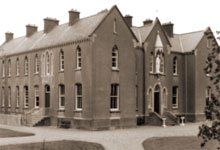
1877 – 1978
Land was bought by the Sisters for £750 for a new Primary School, which was opened on 24th September, 1878. The Sisters discontinued the Pension School in 1880 and the pupils were transferred to the Primary School. On 5th May, 1882, the Sisters came to reside in the new Convent and the first Ceremony, the Profession of Sr. Xavier Johnson took place on May 21st. A further extension was built in 1895. In 1892 the Guardian of the Workhouse asked Sr. Xaviour Johnson to teach in the Workhouse School and Sr. Aloysius Hickey to nurse in the Infirmary. The Sisters continued this work until the closure of the Workhouse in 1921.
In 1922 Bishop Hoare asked the Sisters to provide Second Level Eucation in Ballymahon. A three-roomed building was erected near the National School and named St. Brigid’s Intermediate School for Girls. In September 1924, the School was placed under the Board of Education and in 1932 it was recognised as an all-Irish or A School. In 1937 when a new Primary School was built, the old National School was taken over by the Secondary School which was both Boarding and Day. In 1959 it became a co-educational. Other extensions were added.
1963
A Childcare Group Home was opened in Ballymulvey, Ballymahon in 1993 with Sr. May Lynam in charge.
In 1976 an extensive new Secondary School was built. The building was grant-aided by the Department of Education. This was the first time that Ballymahon had received financial aid for building purposes in its 50 years of existence. Between 1983 and 2000 further extensions of Laboratories, Classrooms and Sports Hall were built. In 1992 the Boarding School was closed.
In the year 2000, the Boys’ National School and the Convent National School amalgamated to form St. Mathew’s School. Classes are presently conducted for boys and girls in the Sacred Heart Convent School.
1890 – St. Vincent’s Hospital, Athlone, Co Westmeath:
In 1880, Athlone Board of Guardians applied to Dr. Woodlock, Ardagh and Clonmacnois for Sisters from Moate to undertake the care of the sick poor in the Union Workhouse, Athlone. He consented. Sisters Alacoque, de Sales and Evangelist, after nursing training, commenced work in the Hospital in Easter Week 1890. Later, Srs. Brigid, Clare and Vincent joined them.
When the Amalgamation of Workhouses took place, the Athlone inmates were transferred to The County Home, Mullingar. Athlone Workhouse became a District Hospital, with Sr. Vincent as Matron.
1952 – Lanesborough, Co Longford:
Lanesborough Convent was founded from Ballymahon at the invitation of Bishop James J. McNamee of Ardagh and Clonmacnois and at the request of the people in the Lanesborough area. The first Sisters were – Srs. Michael Fleury, Brigid Grehan and Evangelist Doherty. On the 8th of September, 1953 they opened a Secondary School in a rented premises that had been the local Cinema cum-Ballroom. This premises they later purchased, renovated and extended. In 1957 a Girls’ new National School was built on land given by the Convent. In May, 1958 it was opened with Sr. Clement Lalor as Principal.
 The first Convent in Lanesboro’ on the Longford road
The first Convent in Lanesboro’ on the Longford road
The Sisters living accommodation was a small rented roadside house on the outskirts of the town. In January 1956 the Sisters moved to the renovated School in town. In November 1956 a few of the Sisters moved out to Rathcline House and motored into School each day.
The diminishing school going population towards the end of the 80s led to the merging of the Convent Secondary School with the local Vocational School and a new School – Lanesborough Community College was established on the Vocational School site in 1989.
On 31st May, 1968 the “country” Convent was sold and in March 1972 the Sisters moved into their new Convent beside the girls Secondary School.
Amalgamation
In 1920 at the instigation of Bishop Hoare, the convents in Mohill, Granard, Newtownforbes and Longford were amalgamated. Sr. Cecelia Farrington was Mother General and Sr. Gabriel Noone was Novice Mistress and they resided in Newtownforbes. Srs. Mercy Keane and Patrick Kelly from the Granard Community joined the Newtownforbes Community. Moate and Ballymahon convents were not part of the Amalgamation. Bishop James J. McNamee dissolved the amalgamation in 1929. Mohill remained united to Newtownforbes until 1965, when it became an autonomous Community.
Diocesan Union
In 1978 the Sisters of Mercy in the Diocese with their Overseas Foundations came together as one Congregation known as – The Sisters Of Mercy, Ardagh and Clonmacnoise.
Each Convent/House was autonomous with its own Leader and was governed by The Mother General, Sr. Regina Murphy, and her Council, Srs. Regina Beglan, Clare McNamara, Celine Keegan, and Elizabeth Manning. The Mother General and the first Councillor resided in Villa Maria, Lanesborough in 1978 – 1979. This building was used as offices only in 1979 – 1980.
In 1980 the Villa Maria offices were moved from Lanesborough to Ardagh, in a temporary building. In July 1986 the Ardagh Gate Lodge became vacant. A Conference Room was built and the house renovated. In the Spring of 1987 the Villa Maria Mercy Diocesan offices were opened in the Gate Lodge.
15th August, 1990 – St. Michael’s Road, Longford:
From Diocesan Assembly 1987, with Sr Clare McGovern as Mother General a decision was made to establish a Community in a Council Housing Estate. On 15th August, 1990, with Sr. Elizabeth Manning as Mother General, Sisters Goretti McDermott, Judith Kirwan, Elizabeth Holloway and Angela Clarkson formed this Community, now known as Annaly Gardens – where they lived as neighbours with the people and continued their various Mercy apostolates while they lived there.
January 25th, 1991 – 19 Midara Gardens, Longford:
The Sisters working in St Joseph’s Hospital, Longford lived in Health Board rented accommodation. After Diocesan Chapter 1990 Sr. Elizabeth Manning and Council purchased a house in Midara Gardens. Srs. Pius Dooly, Evangelist Tiernan, and Sr. Anna Burke took up residence there and continued the ministries in which they were already involved.
25th January, 1991 – 6 Curryline, Newtownforbes, Co Longford:
In the Autumn of 1990 architects confirmed that a wing of the Convent in Newtownforbes was unsafe as a living area for the Sisters. Sr. Elizabeth Manning and her Council decided to provide alternative accommodation and bought a vacant house in Curryline area of Newtownforbes. On 25th January, 1991, a cold and frosty evening, Srs. Joseph (Eileen) Flannery, Clare McDermott, Joan Ham and Elizabeth Tierney moved in. Srs. Joseph (Principal) and Clare taught in the Girls’ Primary School. Sr. Joan (Principal) and Sr. Elizabeth Tierney taught in St. Joseph’s Secondary School.
7th March, 1991 – Coosan, Athlone, Co Westmeath:
At Diocesan Chapter 1990 it was suggested that Sisters living in Health Board accommodation would investigate the possibility of purchasing their own house. As a result this house was purchased and on 7th March, 1991, Srs. Assumpta Kane, Nuala McDonnell, Kathleen Lee and Catherine Roche, all from St. Vincent’s Hospital Convent, Athlone, came to Coosan and continued their work in the Hospital while they lived there.
February 1991 – Bethany, Station Road, Moate, Co Westmeath:
The Diocesan Chapter of 1990 encouraged the exploration of living in Small Communities. The large Convent in Moate had become unsafe. In 1970 the local Bank Manager built a house on a site purchased from the Sisters. It was bought back by Sr. Elizabeth Manning and her Council in 1990. In February 1991 the Sisters moved into that house. They continued their Mercy ministries while they lived there.
15th August, 1992 – Drumshambo, Co Leitrim:
In February 1992, then Bishop Colm O’Reilly, at the request of Mother Angela, Abbess of the Poor Clare Convent in Drumshanbo, approached Sr. Elizabeth Manning, Superior General, as to the possibility of forming a Community of Mercy Sisters who would live in the Lodge adjoining the Poor Clare Convent. The Mercy Sisters would work closely with the Poor Clare Nuns and also develop a Mercy Apostolate in the Parish. This request was welcomed, since, at our Diocesan Chapter in 1990, the Congregation had committed itself to addressing the needs in Rural Areas.
On August 15th, 1992, Srs. Joseph Regan, Alphonsus O’Brien, Clare McDermott and Helen Keegan formed the new Community. This was a new venture for both Congregations. Bishop Colm O’Reilly blessed the house and celebrated Mass in the Convent Chapel. On 16th August the Bishop celebrated Mass in the Parish Church and presented the four Sisters to the people, explaining their Mission and Apostolate. In his Homily, he showed how Contemplative Nuns, Active Sisters and People should all pray and work together for the good of the whole People of God. Their Apostolate included Teaching, Prayer Groups, Retreat Centres, Visitation, Choirs, Serving the external needs of the Enclosed Poor Clare Sisters.
30th June, 1993 -Mount Carmel, Moate, Co Westmeath:
Ath-an-Airgid was the first Department financed Group Home. The site was given by the Sisters. It was officially opened on October 18th, 1973. The conditions were the Sisters own the site which was to be used for childcare for 20 years, when the Sisters would then own the house.
On June 30th, 1993 the Sisters took back the building for use as a Community House as the Convent had to be vacated before being demolished. In August 1993, Srs. Xavier Molloy, Ignatius Hanrahan, Aquin O’Sullivan, Oliver Holloway, Teresa Keegan, May Lynam, May Keegan, Mary Fox and Martina Healy moved into this house in August 1993 and continued their involvement in their former ministries.
25 August, 1993 – 4 Church Street, Edgeworthstown, Co Longford:
In August 1992, due to the size of St. Elizabeth’s Convent, Edgeworthstown for five Sisters and the mounting cost of maintenance of the grounds, Sr. Elizabeth Manning, in consultation with the Community, decided to sell the Convent. A small 3 bedroomed terraced house was bought – No 4 Church Street – for the three Sisters whose ministry was in the area.
On August 25th, 1993, Srs. Angels Curran, Maureen Brennan and Kathleen Flood moved into that new area. The Convent was leased to the Midland Health Board for the first year and finally, purchased by the Health Board.
Summer 1993 – Sancta Maria, Hall Road, Moate, Co Westmeath:
When Sr. Elizabeth was Superior of the Convent in Moate it was recommended by the engineers that the Convent should be vacated, as it was in a dangerous condition. When this house was bought the following Sisters took up residence there – Gabriel O’Reilly, Olive Donohoe, Agnes Mee, Clare McNamara, Johanna McGovern and Paul Lehane. From there they continued their various Mercy works.
Overseas Foundations
Through the 1950’s an urgent call from the American Church for help in Catholic Education found a ready response in the hearts of many Sisters. Mercy foundations were made in :
Nevada – Ely, August 1958 and Reno 1962 (Longford Convent)
Florida – Palm Bay 1963, (Newtownforbes) Lake Worth 1963 (Moate)
Missouri – Columbia 25th August 1960, Fulton 1970, Kirksville 1976 (Ballymahon)
Zambian Mission – July 1983
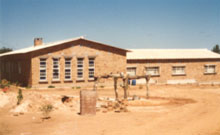 The Convent – Lundazi – 1984
The Convent – Lundazi – 1984
In response to the call of the Assembly of 1981 to found an African Mercy Mission, Sr. Regina Murphy, Mother General and Sr. Regina Beglan went to the diocese of Chipata to explore the situation. Six priests of the Ardagh and Clonmacnois were already on Mission there. It was decided to make the foundation in Lundazi, in the northern part of the Diocese, it being one of the most needy parishes.
In July 1983, Sisters Teresa Sheeran, Alphonsus O’Brien, Anna Burke, Mary McWeeney and Mary Doherty were the pioneering Sisters who would be part of the prayer, life and of the Parish through their work in the State and Mission Hospitals and in the Schools.
The Sisters of Mercy have well and truly given over 140 years of sacrifice and fruitful service, and opened doors of opportunity, not only to the people of Ardagh and Clonmacnois, but to the Church and State in Ireland and throughout the world.
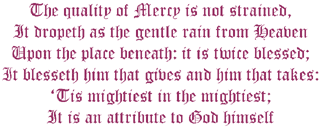 William Shakespeare
William Shakespeare
Achonry | Ardagh & Clonmacnois | Clonfert | Elphin | Galway | Killala | Tuam


